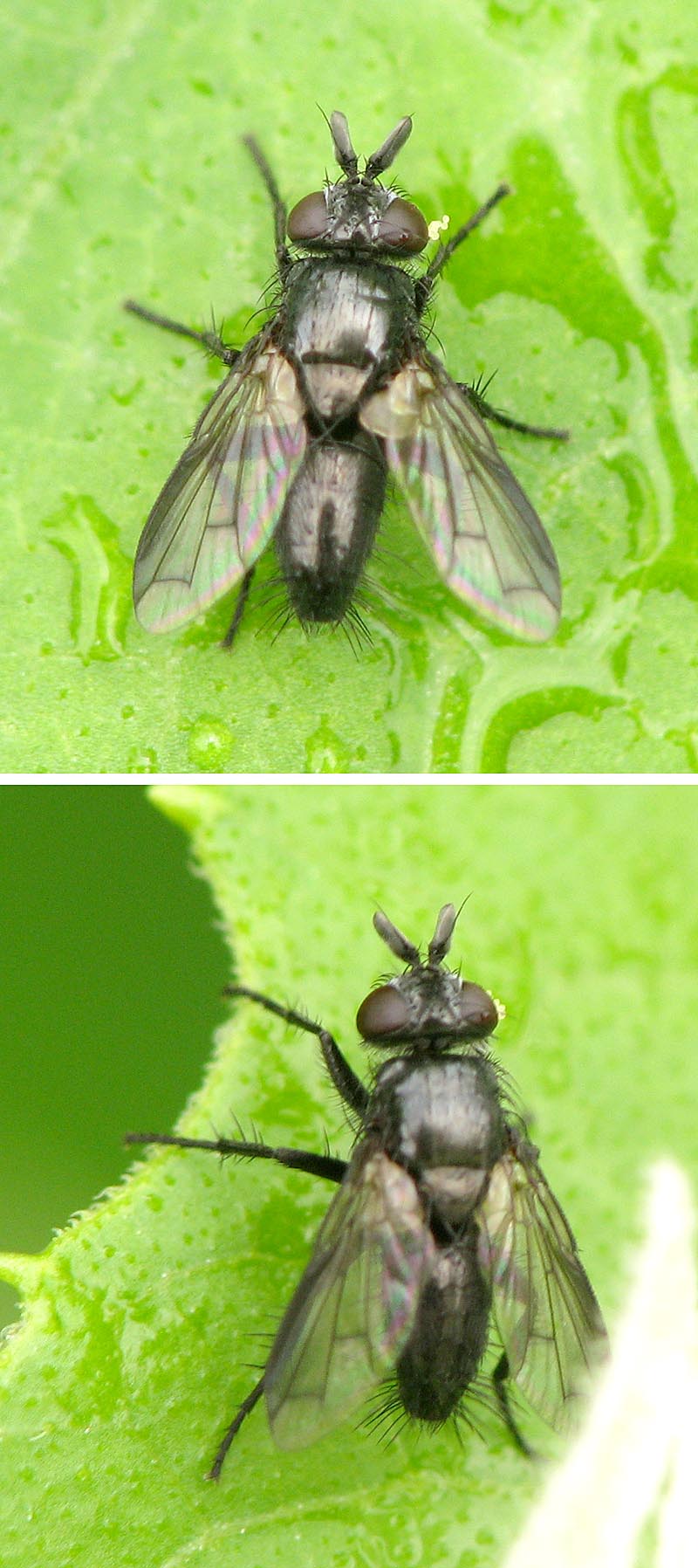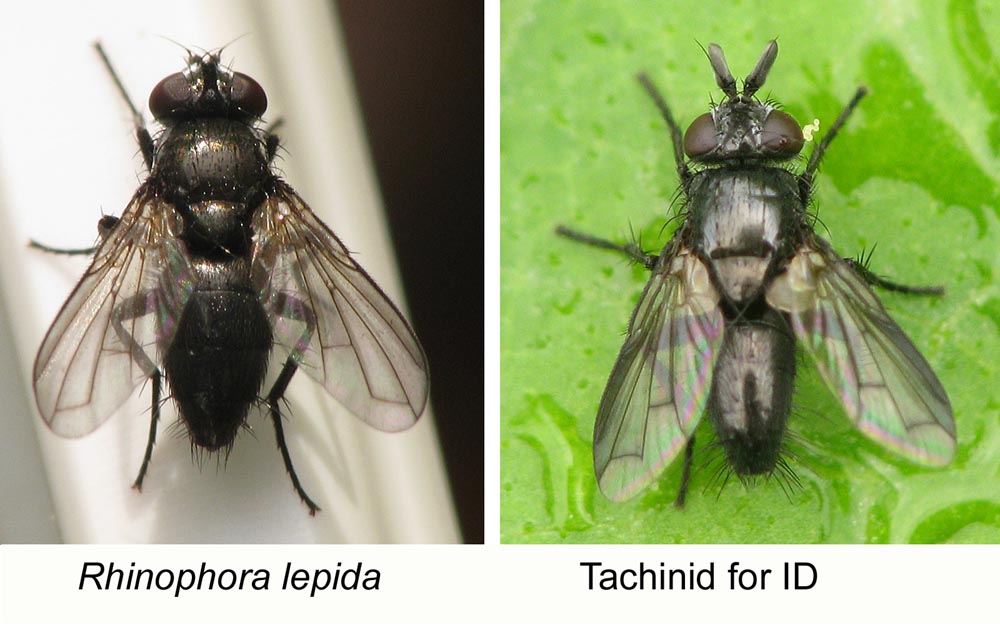Diptera.info :: Identification queries :: Diptera (adults)
|
small black Tachinid - Wagneriini
|
|
| Sundew |
Posted on 22-08-2011 14:14
|
|
Member Location: Berlin and Baden-Württemberg, Germany Posts: 3938 Joined: 28.07.07 |
Hi, On 1st August I watched a small dark fly with petiolate wing venation, and my first thought was, "a boring Rhinophora lepida again." However, now I see that the big antennae look tachinidish! So my second idea is Leucostoma, but are the calypters big enough? For a poor "just by jizz" identifier this task is too big, so I need help! (I took only a few, not too good, pics, as I had already enough Rhinophora stuff. I wished I had taken a closer look!  ) )Many thanks, Sundew Sundew attached the following image:  [167.35Kb] Edited by Sundew on 23-08-2011 20:43 |
|
|
|
| Sundew |
Posted on 23-08-2011 08:39
|
|
Member Location: Berlin and Baden-Württemberg, Germany Posts: 3938 Joined: 28.07.07 |
Don't overlook the little one, please! |
|
|
|
| ChrisR |
Posted on 23-08-2011 09:33
|
|
Super Administrator Location: Reading, England Posts: 7706 Joined: 12.07.04 |
I guessed Rhinophora lepida - from size & general appearance but you might have something that looks similar there that I am not aware of - let's wait for theo or Erikas 
Manager of the UK Species Inventory in the Angela Marmont Centre for UK Biodiversity at the Natural History Museum, London. |
| Stephane Lebrun |
Posted on 23-08-2011 10:18
|
|
Member Location: Le Havre, France Posts: 8248 Joined: 03.03.07 |
The calypters are adjacent to the lateral margin of scutellum : this is a Tachinidae, in the Wagneriini tribe I suppose.
Stephane. |
|
|
|
| sd |
Posted on 23-08-2011 17:59
|
|
Member Location: Suffolk, UK Posts: 892 Joined: 11.10.07 |
Is it not Periscepsia? I have been looking for this here in Suffolk on the coast without success so far Steve |
|
|
|
| jorgemotalmeida |
Posted on 23-08-2011 18:08
|
|
Member Location: Viseu - PORTUGAL Posts: 9296 Joined: 05.06.06 |
good tip - calypters are very small in Rhinophoridae (and almost all have petiole). I wonder about Wagneria... |
| ChrisR |
Posted on 23-08-2011 18:43
|
|
Super Administrator Location: Reading, England Posts: 7706 Joined: 12.07.04 |
I have to admit that the Wagneriini are a bit of mystery to me - with the exception of Ramonda spatulata I see them very rarely 
Manager of the UK Species Inventory in the Angela Marmont Centre for UK Biodiversity at the Natural History Museum, London. |
| Sundew |
Posted on 23-08-2011 19:18
|
|
Member Location: Berlin and Baden-Württemberg, Germany Posts: 3938 Joined: 28.07.07 |
Very interesting comments indeed! The Periscepsia images in the gallery seem to be a close match. For comparison, I add a picture of Rhinophora lepida. There are a lot of differences not only concerning the calypters, but also antenna size and bending of the wing veins. And the Tachinid's wings are a bit darkened along the outer edge.
Sundew attached the following image:  [102.13Kb] Edited by Sundew on 23-08-2011 20:39 |
|
|
|
| neprisikiski |
Posted on 23-08-2011 19:46
|
|
Member Location: Lithuania Posts: 876 Joined: 23.02.09 |
I think, it is a Ramonda sp., in Wagneria depression of tergite 2 does not reach the tergite margin.
Edited by neprisikiski on 23-08-2011 19:47 Erikas |
|
|
|
| Sundew |
Posted on 23-08-2011 20:36
|
|
Member Location: Berlin and Baden-Württemberg, Germany Posts: 3938 Joined: 28.07.07 |
Dear friends, meanwhile I read all I could find about the Wagneriini in the forum archive  . This is not the first thread that came to an (open) end with Ramonda versus Wagneria versus Periscepsia. We can exclude Ramonda spathulata, and that's it. The pictures show by far too few details to allow a well-based guess. I shall label them "cf. Ramonda" and add all your helpful remarks. The most important I learned is not to carelessly put all the little petiolate blackies in the Rhinophora-pot. I'll keep Wagneriini in mind forever! Many thanks to you all. . This is not the first thread that came to an (open) end with Ramonda versus Wagneria versus Periscepsia. We can exclude Ramonda spathulata, and that's it. The pictures show by far too few details to allow a well-based guess. I shall label them "cf. Ramonda" and add all your helpful remarks. The most important I learned is not to carelessly put all the little petiolate blackies in the Rhinophora-pot. I'll keep Wagneriini in mind forever! Many thanks to you all.
Edited by Sundew on 23-08-2011 20:38 |
|
|
|
| Zeegers |
Posted on 06-11-2011 17:38
|
|
Member Location: Soest, NL Posts: 19213 Joined: 21.07.04 |
It is probably a Ramonda, but I can't be sure. All these Wagneriini (with the exceptions mentioned above) are pretty similar ! Ramonda prunaria is the most common one (except for spathulata, ruled out above) Theo |
|
|
|
| Sundew |
Posted on 06-11-2011 19:57
|
|
Member Location: Berlin and Baden-Württemberg, Germany Posts: 3938 Joined: 28.07.07 |
Many thanks Theo, for these final words. |
|
|
|
| Jump to Forum: |













